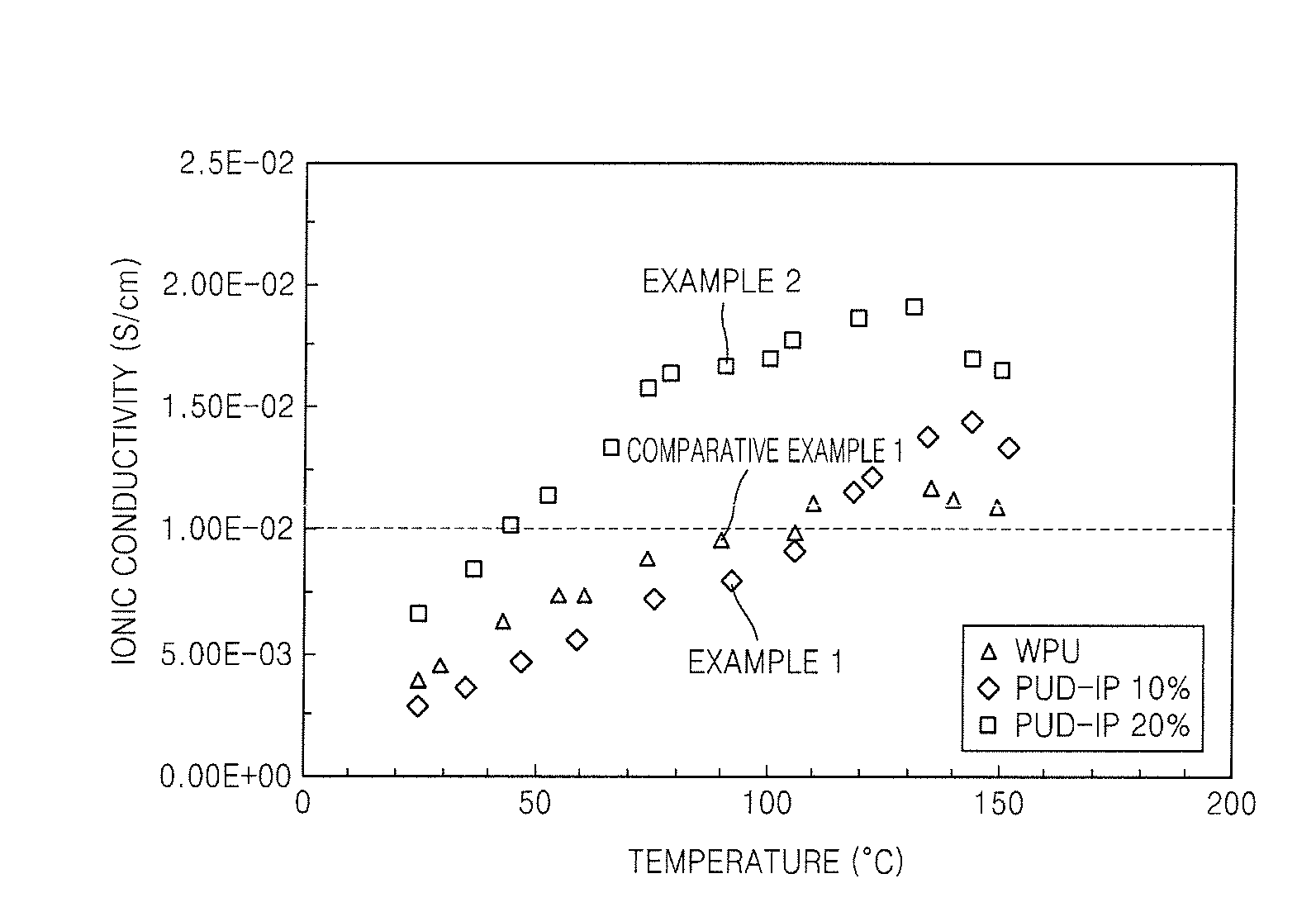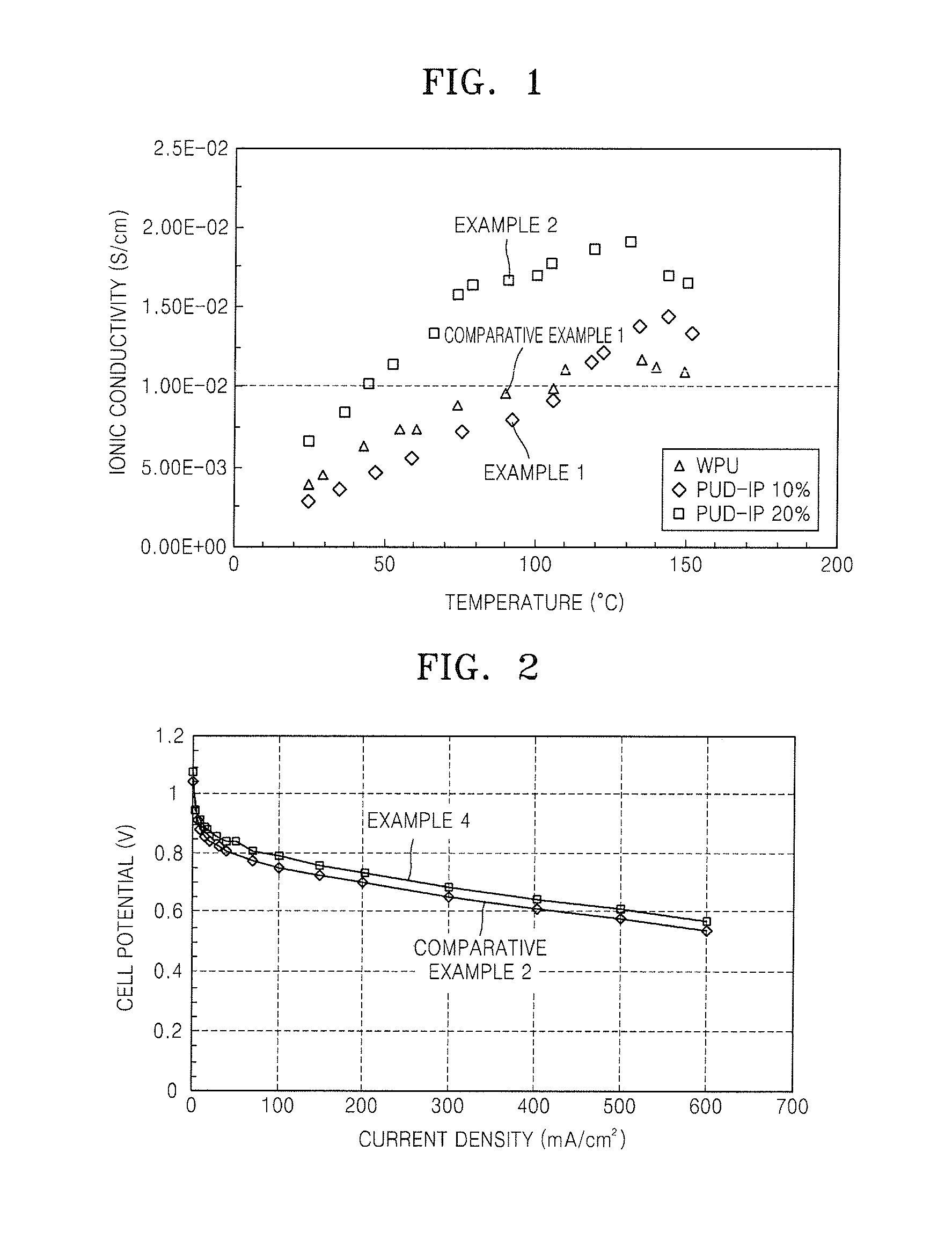Polymer electrolyte, method of preparing the same, and fuel cell using the polymer electrolyte
a polymer electrolyte and polymer technology, applied in the field of polymer electrolyte, can solve the problems of insufficient long-term stability, insufficient energy generation efficiency of solid polymer electrolyte membranes described above, and insufficient long-term stability, so as to improve energy generation efficiency and excellent ionic conductivity
- Summary
- Abstract
- Description
- Claims
- Application Information
AI Technical Summary
Benefits of technology
Problems solved by technology
Method used
Image
Examples
synthesis example 1
Synthesis of Polyurethane (Using 10 Mole % of FYROL-6 (The bis-(2-hydroxyethyl)-amino]-methyl}-phosphonic acid diethyl ester Shown by Formula 3, Above) (Akzo Nobel Chemicals Inc.) as a Phosphoric Acid-Based Polyol, and 90 Mole % of Polytetramethylene Ether Glycol as a Polyol)
[0070]60 parts by weight of polytetramethylene ether glycol having a number average molecular weight of 1,000, 30 parts by weight of isophorone diisocyanate, 6 parts by weight of FYROL-6 (Akzo Nobel Chemicals Inc.) having a number average molecular weight of 255 as a phosphoric acid-based polyol, 4 parts by weight of ethylene diamine as a chain extender and 300 parts by weight of water as a solvent were mixed and reacted at 60° C. to synthesize a waterborne polyurethane.
synthesis example 2
Synthesis of Polyurethane (Using 20 Mole % of FYROL-6 as a Phosphoric Acid-Based Polyol, and 80 Mole % of Polytetramethylene Ether Glycol as a Polyol)
[0071]The waterborne polyurethane was synthesized in the same manner as in Synthesis Example 1, except that 48 parts by weight of polytetramethylene ether glycol having a number average molecular weight of 1,000, 30 parts by weight of isophorone diisocyanate, and 12 parts by weight of FYROL-6 (Akzo Nobel Chemicals Inc.) having a number average molecular weight of 255 as a phosphoric acid-based polyol were used.
example 1
Preparation of the Polymer Electrolyte Membrane
[0073]70 parts by weight of the waterborne polyurethane obtained according to Synthesis Example 1, 10 parts by weight of an aziridine-based compound and 20 parts by weight of EPOCROS (Nippon Shokubai Co.) were added to a mixture prepared by adding 100% ammonia water to 40 parts by weight of PEAA (Primacor 5980, Dow Chemical) and mixed, and deionized water as a solvent was added thereto and stirred.
[0074]The mixture was cast and polymerized at 120° C. for 4 hours, and the resultant was heat-treated at 250° C. for 24 hours to prepare a membrane having a thickness of about 40 μm.
[0075]The prepared membrane was impregnated with 85 wt % phosphoric acid at room temperature for 2 hours to prepare a polymer electrolyte.
PUM
| Property | Measurement | Unit |
|---|---|---|
| temperature | aaaaa | aaaaa |
| temperature | aaaaa | aaaaa |
| operating temperature | aaaaa | aaaaa |
Abstract
Description
Claims
Application Information
 Login to View More
Login to View More - R&D
- Intellectual Property
- Life Sciences
- Materials
- Tech Scout
- Unparalleled Data Quality
- Higher Quality Content
- 60% Fewer Hallucinations
Browse by: Latest US Patents, China's latest patents, Technical Efficacy Thesaurus, Application Domain, Technology Topic, Popular Technical Reports.
© 2025 PatSnap. All rights reserved.Legal|Privacy policy|Modern Slavery Act Transparency Statement|Sitemap|About US| Contact US: help@patsnap.com



